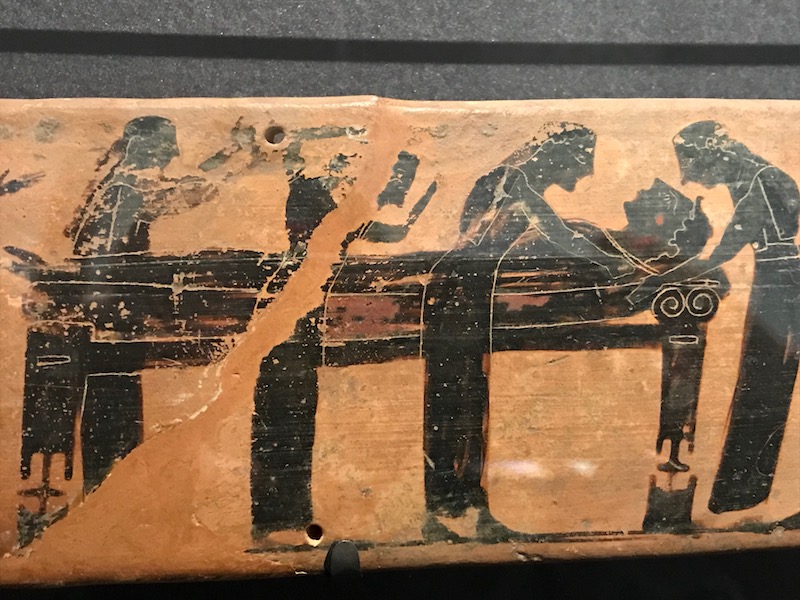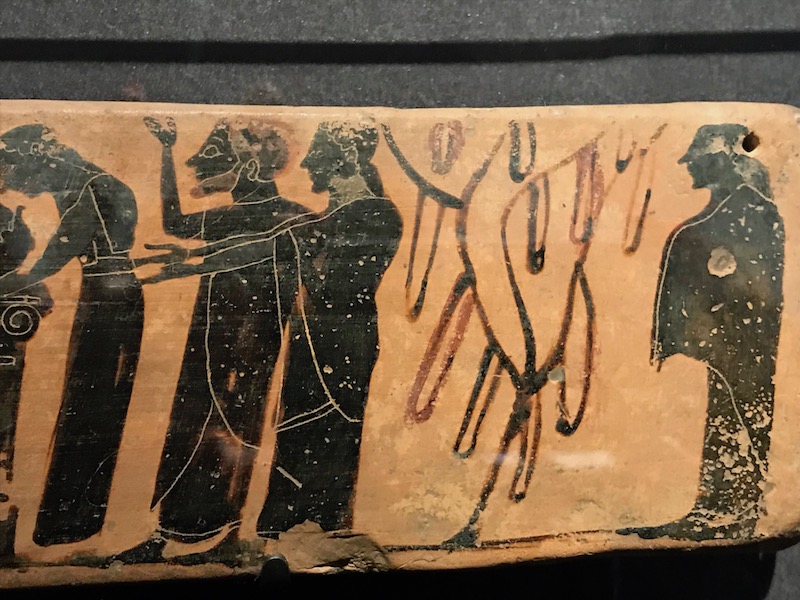Our Blog - Special Exhibit - Greek Rituals
This was a special exhibit of items from the Louvre in Paris, which was being shown for a few months at the Musee Saint Raymond, which is the museum which has the very old Roman artifacts from this area. It had around 40 artifacts that walk you through 4 main rituals of ancient Greece: Marriage, Sacrifice, Banquets, and Funerals. These are the four moments in the life of the Greeks during which the gods intervened in different ways: to protect the girl who becomes a woman during her marriage, to ensure the journey into the hereafter at the time of the funeral, etc. They used a variety of ways to ensure that the gods would be present and to communicate with them, including offering perfumed products (flowers, oils), playing music, reciting prayers, etc.
The first ritual was marriage. Here is a vase dating back to 400 BC and shows the bride-to-be the evening before her marriage. She has put her clothes to the side and is washing herself next to a basin of water, which would have been perfumed with oils and flowers. She gazes at herself in a mirror as she combs her hair. Another woman, on the right, is holding a box. The same ritual would also be done by the husband to be (but separately). The washing of the body and applying of perfumed oils signifies the "washing" of the traces of childhood as they move into their adult life together.
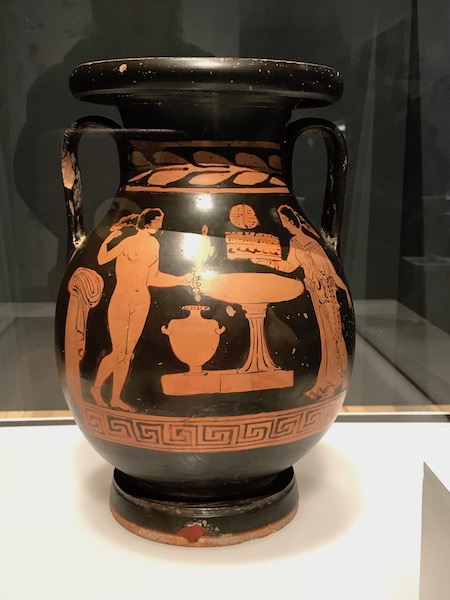
This vase, from around 540 BC is actually from the British Museum in London. It shows the married couple being transported on a bige, a two-wheeled chariot, pulled by a pair of horses. Between the horses and the couple in the chariot, you can see 3 young women carrying baskets on their heads, which contain gifts received by the couple. Hard to see, but all the way on the right is a bearded man representing Hermes, god of passage, who accompanies the couple as they change their status to being a married couple, guaranteeing a solid marriage.

They did a really good job, in my opinion, of designing this exhibit to somewhat bring these things "to life", and make it really a bit more interactive than just walking around looking at things. There were various areas with headphones to listen to music or readings that would have been used within the ritual. Here, you can see one of the stations around makeup, and you can see that you were supposed to feel and smell certain things (the hand and/or the nose) but not eat (lips with a line through) and the last thing, a crown, you can't touch. It talks about the makeup that would be worn by the bride. They would put white power on their face, and then add color back for their eyes, cheeks, and lips.


The next section dealt with sacrifice of animals. They went into a lot of detail on this, including cleaning and decorating the animal with ribbons, the procession to the altar where it would occur, and a bit of what happened at the altar. The actual sacrifice would be done quickly, by slitting the throat of the animal, so that it was not seen as an act of violence (although the animal may disagree). There was then a feast for both the gods and the humans. The gods were "fed" from the smoke rising up from the burning of the bones. Here we have a marble bas-relief of the procession towards the sacrificial altar. You can see the round altar with the sheep, and a boy with a basket which would have grains to toss on the head of the animal. The knife that will be used would be hidden within the basket. The large figure to the right represents the goddess Demeter, who was the goddess of agriculture, grain and bread. In this case, the sacrifice most likely would be to ask her to help them to have a plentiful harvest.

They also went through the 3rd ritual, which was the banquet, although I didn't see anything exciting to take a picture of. The last ritual, the funeral, was a bit more interesting to me. Here is a vase from 500 BC. It is a cantharose, which is a deep vase for drinking wine, characterized by high, vertical handles. On the side is the view of a funeral procession, where you can see 4 men carrying the deceased on their shoulders towards his tomb.
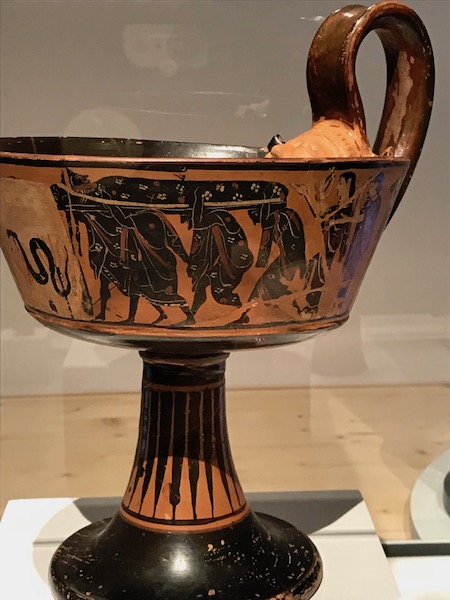
This one was also very interesting, hence the multiple pictures. It is a pinax, which is a votive funerary plaque from 550 BC, which would have been attached on a tomb. The first picture is the whole thing, and then I took close-up pictures of each segment. This scene would take place in the courtyard of the house.
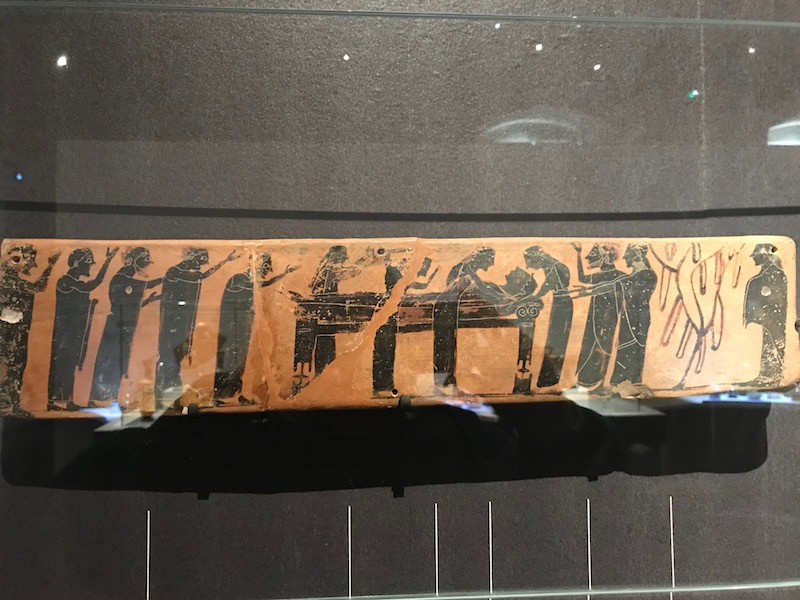
Starting from the left, you see 5 men who are visitors. Each has their right hand raised, which is a sign of salutation and homage. Moving right, the next group shows the deceased (already wrapped and laying on a wooden bed) with 4 women. The two women on the left have their arms raised, expressing their grief. Then two other women are taking care of the body. At the right, a man and woman (perhaps his family members) are welcoming the visitors with outstretched arms. Behind them is a tree with knotted strips that are offerings to the dead.

